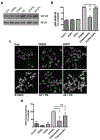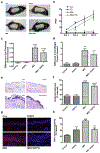Phosphatidylglycerol Inhibits Toll-Like Receptor-Mediated Inflammation by Danger-Associated Molecular Patterns
- PMID: 30391260
- PMCID: PMC7309510
- DOI: 10.1016/j.jid.2018.10.021
Phosphatidylglycerol Inhibits Toll-Like Receptor-Mediated Inflammation by Danger-Associated Molecular Patterns
Abstract
Psoriasis is a common skin disorder characterized by hyperproliferation and aberrant differentiation of epidermal keratinocytes and inflammation. We previously showed that phosphatidylglycerol (PG) can regulate keratinocyte function and suppress skin inflammation. Based on data suggesting that PG can inhibit toll-like receptor (TLR) activation induced by microorganisms and their components, we determined whether PG can inhibit TLR activation in response to antimicrobial peptides. These peptides, which are up-regulated in psoriasis, are known to function as danger-associated molecular patterns (i.e., DAMPs) to activate TLRs and the innate immune system. Because S100A9 is elevated in psoriatic skin and in animal models of psoriasis, we selected S100A9 as a representative antimicrobial peptide DAMP. We showed that in primary keratinocytes and a macrophage cell line, PG suppressed inflammatory mediator production induced by recombinant S100A9 functioning through both TLR2 and TLR4. In addition, PG, but not phosphatidylcholine, inhibited downstream S100A9-elicited TLR2 and NF-κB activation. These results, to our knowledge previously unreported, show PG's ability to inhibit DAMP-induced TLR activation, thereby reducing inflammatory signals. In addition, topical PG ameliorated skin lesions and inflammation in a mouse model of psoriasis. Together, these results suggest the possibility of developing PG as a therapy for psoriasis.
Copyright © 2018 The Authors. Published by Elsevier Inc. All rights reserved.
Conflict of interest statement
Conflict of Interest
Dr. Bollag is an inventor on a patent awarded to Augusta University for the use of phosphatidylglycerol to modulate skin function.
Figures





Similar articles
-
Pathogen-Associated Molecular Pattern-Induced TLR2 and TLR4 Activation Increases Keratinocyte Production of Inflammatory Mediators and is Inhibited by Phosphatidylglycerol.Mol Pharmacol. 2020 May;97(5):324-335. doi: 10.1124/mol.119.118166. Epub 2020 Mar 15. Mol Pharmacol. 2020. PMID: 32173651 Free PMC article.
-
Interleukin 17 Promotes Expression of Alarmins S100A8 and S100A9 During the Inflammatory Response of Keratinocytes.Front Immunol. 2021 Feb 12;11:599947. doi: 10.3389/fimmu.2020.599947. eCollection 2020. Front Immunol. 2021. PMID: 33643287 Free PMC article.
-
Upregulation of ANGPTL6 in mouse keratinocytes enhances susceptibility to psoriasis.Sci Rep. 2016 Oct 4;6:34690. doi: 10.1038/srep34690. Sci Rep. 2016. PMID: 27698489 Free PMC article.
-
The Role of Toll-Like Receptors in Skin Host Defense, Psoriasis, and Atopic Dermatitis.J Immunol Res. 2019 Nov 14;2019:1824624. doi: 10.1155/2019/1824624. eCollection 2019. J Immunol Res. 2019. PMID: 31815151 Free PMC article. Review.
-
Epidermal activation of the small GTPase Rac1 in psoriasis pathogenesis.Small GTPases. 2019 May;10(3):163-168. doi: 10.1080/21541248.2016.1273861. Epub 2017 May 4. Small GTPases. 2019. PMID: 28055293 Free PMC article. Review.
Cited by
-
Network analysis of potential risk genes for psoriasis.Hereditas. 2021 Jun 16;158(1):21. doi: 10.1186/s41065-021-00186-w. Hereditas. 2021. PMID: 34134787 Free PMC article.
-
The Effects of 12 Weeks Colostrum Milk Supplementation on the Expression Levels of Pro-Inflammatory Mediators and Metabolic Changes among Older Adults: Findings from the Biomarkers and Untargeted Metabolomic Analysis.Nutrients. 2023 Jul 18;15(14):3184. doi: 10.3390/nu15143184. Nutrients. 2023. PMID: 37513601 Free PMC article.
-
Updated Perspectives on Keratinocytes and Psoriasis: Keratinocytes are More Than Innocent Bystanders.Psoriasis (Auckl). 2022 May 2;12:73-87. doi: 10.2147/PTT.S327310. eCollection 2022. Psoriasis (Auckl). 2022. PMID: 35529056 Free PMC article. Review.
-
Loss of Indoleamine-2,3-Dioxygenase-1 (IDO1) in Knockout Mice Does Not Affect the Development of Skin Lesions in the Imiquimod-Induced Mouse Model of Psoriasis.Int J Tryptophan Res. 2022 Feb 28;15:11786469221078191. doi: 10.1177/11786469221078191. eCollection 2022. Int J Tryptophan Res. 2022. PMID: 35250276 Free PMC article.
-
Ozone Therapy Attenuates NF-κB-Mediated Local Inflammatory Response and Activation of Th17 Cells in Treatment for Psoriasis.Int J Biol Sci. 2020 Apr 6;16(11):1833-1845. doi: 10.7150/ijbs.41940. eCollection 2020. Int J Biol Sci. 2020. PMID: 32398953 Free PMC article.
References
-
- Bailey LJ, Choudhary V, Merai P, Bollag WB. Preparation of primary cultures of mouse epidermal keratinocytes and the measurement of phospholipase D activity. Meth Mol Biol 2014;1195:111–31. - PubMed
-
- Balato A, Balato N, Megna M, Schiattarella M, Lembo S, Ayala F. Pathogenesis of Psoriasis: The Role of Pro-Inflammatory Cytokines Produced by Keratinocytes,. In: Soung J, editor. Psoriasis; http://cdn.intechweb.org/pdfs/28300.pdf InTech; 2012.
-
- Bollag WB, Xie D, Zhong X, Zheng X. A potential role for the phospholipase D2-aquaporin-3 signaling module in early keratinocyte differentiation: Production of a novel phosphatidylglycerol lipid signal. J Invest Dermatol 2007;127:2823–31. - PubMed
-
- Brotas AM, Cunha JM, Lago EH, Machado CC, Carneiro SC. Tumor necrosis factor-alpha and the cytokine network in psoriasis. An Bras Dermatol 2012;87(5):673–81; quiz 82–3. - PubMed
Publication types
MeSH terms
Substances
Grants and funding
LinkOut - more resources
Full Text Sources
Medical
Miscellaneous

